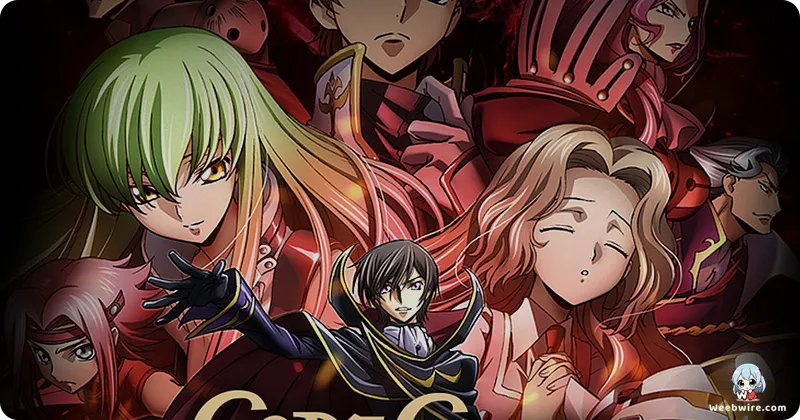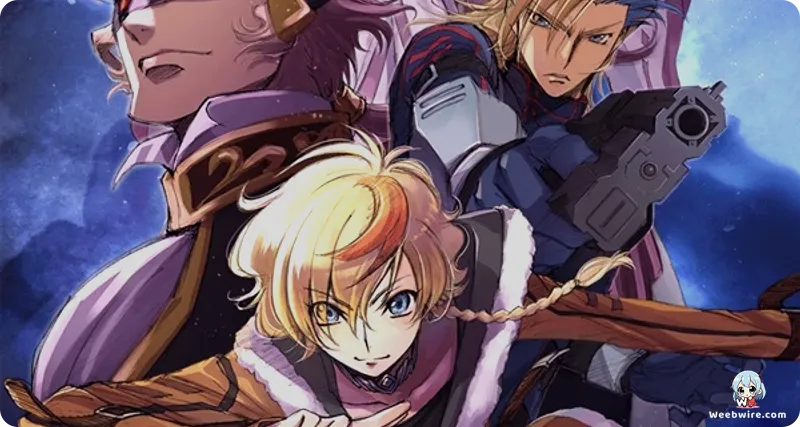Decoding Code Geass: Unearthing the Masterpiece's Hidden Layers and Production Secrets

Code Geass: Lelouch of the Rebellion stands as a titan in the anime landscape, a masterpiece seamlessly weaving together complex political machinations, exhilarating mecha combat, and profound philosophical inquiries. Its enduring allure extends far beyond its captivating narrative and the magnetic charisma of its protagonist, Lelouch vi Britannia. Years after its initial broadcast and the subsequent release of acclaimed compilation films like 'Code Geass: Lelouch of the Rebellion I - Initiation', both ardent fans and new viewers continue to unearth surprising insights that deepen their appreciation for this seminal work.
CLAMP's Distinctive Character Designs
A cornerstone of Code Geass's unique identity lies in its distinctive character designs, masterfully penned by the legendary manga artist collective CLAMP. This groundbreaking collaboration was a deliberate stroke of genius by director Gorō Taniguchi and writer Ichirō Ōkouchi, who sought a visual signature that would set the series apart from its mecha contemporaries. CLAMP’s characteristic elongated figures and deeply expressive eyes bestowed upon characters like Lelouch, Suzaku, and C.C. an immediate recognition and an unparalleled elegance. It is a fascinating, lesser-known detail that CLAMP initially faced considerable hurdles in designing the male characters, particularly Lelouch, struggling to meld their signature aesthetic with the dynamic requirements of an action-packed series. Yet, their eventual designs became inextricably linked to the series' success, significantly fueling its widespread popularity and fan devotion. This artistic synergy extended beyond mere character outlines, influencing the entire visual fabric of the world, from the sophisticated uniforms to the intricate symbolism of the Geass.
The Nuances of Geass
The very essence of Geass, the supernatural power central to the unfolding drama, is laden with intriguing complexities. Often perceived as a straightforward mind-control ability, Lelouch’s Geass – the Power of Absolute Obedience – carries a critical limitation: it can be activated only once on any given individual. This crucial constraint compels Lelouch to constantly innovate and strategize, preventing him from simply overwhelming every adversary. Moreover, Geass manifests uniquely in different users, reflecting their deepest desires or psychological states. Consider Mao's Geass, which granted him the ability to hear others' thoughts, ultimately driving him to madness due to its uncontrollable nature – a stark illustration of such immense power's perilous duality. The enigmatic source of Geass, the mysterious collective unconsciousness known as the World of C, along with its ties to figures like C.C. and V.V., layers the narrative with philosophical depth, prompting viewers to ponder the eternal struggle between free will and predestination. The iconic visual of glowing symbols manifesting in the eyes upon Geass activation instantly became a globally recognized hallmark of the series.
Innovative Knightmare Frames
Beyond the compelling characters and their formidable powers, the series' signature mecha, the Knightmare Frames, also boast a wealth of innovative design choices. Diverging from traditional super robots or rigid military mechs, Knightmare Frames brilliantly fuse elements of both, featuring humanoid forms while integrating practical combat applications such as the Landspinners for unparalleled high-speed maneuverability. The designs, particularly those of the agile Lancelot and the formidable Guren, were meticulously crafted to mirror their pilots' distinct personalities and fighting styles. The Lancelot, piloted by the principled Suzaku, embodies sleek agility, emphasizing speed and precision, whereas the Guren, commanded by the fiery Kallen, is robust and potent, engineered for devastating close-quarters combat with its radiant wave arm. A captivating piece of trivia reveals that the initial concept for Knightmare Frames was even more fantastical; however, the design team at Sunrise, including mechanical designer Akira Yasuda, diligently worked to ground them in a semblance of technological plausibility, rendering them believable, albeit advanced, combat vehicles within the series’ universe. Their transformative capabilities and diverse weaponry further injected a layer of strategic complexity into the battles, elevating them beyond mere power clashes.
Sunrise's Ambitious Vision
Sunrise, the renowned production studio with a storied legacy in mecha anime, brought its extensive expertise to Code Geass, yet the series pushed even their boundaries. Director Gorō Taniguchi envisioned a story that transcended robotic warfare, aiming for a complex human drama exploring themes of justice, sacrifice, and the profound consequences of wielding power. This ambitious vision necessitated a meticulous scripting process where writer Ichirō Ōkouchi intensely focused on character motivations and intricate plot twists, ensuring that every episode propelled the overarching narrative forward. The sheer multitude of pivotal characters, each with their own intricate arcs and shifting allegiances, demanded an unprecedented level of coordination within the writing room. The audacious decision to portray Lelouch as a morally ambiguous protagonist, often resorting to ruthless tactics for what he perceived as a greater good, boldly defied typical anime hero archetypes and ignited fervent discussions among viewers. This inherent complexity is a key reason why the series retains its high rewatchability and continues to be debated years after its conclusion.

The Compilation Films: A Fresh Perspective
'Code Geass: Lelouch of the Rebellion I - Initiation', the inaugural installment of three compilation films released a decade after the original series, served not merely as a recap but introduced subtle alterations and new scenes, offering fresh perspectives on the established narrative. While primarily condensing the first season's events, these films facilitated a re-evaluation of pacing and character emphasis, sometimes amplifying specific emotional beats or clarifying plot points that may have been ambiguous in the original episodic format. This extensive re-editing process was a monumental undertaking, requiring the animation team to revisit and, at times, redraw frames to ensure seamless flow, thereby providing a revitalized viewing experience for long-time enthusiasts while acting as an accessible entry point for new audiences. The deliberate choice to re-dub certain lines and re-record musical tracks for the compilation films further underscored the production team’s unwavering dedication to presenting the story in its most polished and impactful form, ensuring that even a familiar narrative could unveil new nuances.
Enduring Cultural Impact
The series' widespread cultural impact stands as a powerful testament to its unique qualities. Code Geass effortlessly transcended conventional anime fan circles, garnering widespread critical acclaim for its intricate plot and profound character development. Its influence is unmistakably visible in subsequent anime and manga that grapple with similar themes of rebellion, moral ambiguity, and the strategic application of intellect. Lelouch vi Britannia, in particular, has cemented his status as an iconic figure, frequently cited in discussions surrounding anti-heroes and charismatic leaders in fiction. His enigmatic 'Zero' persona and the resonating chant of 'All Hail Lelouch!' strike a deep chord with fans, symbolizing a defiant stand against oppression and a battle for a better world, even if achieved through controversial means. The series also ignited countless fan theories, particularly concerning Lelouch’s ultimate destiny, which remains a subject of passionate debate even after subsequent movie releases, underscoring the deep level of engagement the narrative inspired. The unforgettable soundtrack, featuring brilliant compositions by Kōtarō Nakagawa and Hitomi Kuroishi, further solidified its place in anime history, with tracks like 'Stories' and 'Continued Story' becoming synonymous with the series' most poignant moments. The masterful fusion of classical elements with contemporary scoring techniques amplified the drama and tension, imbuing every scene, from hushed conversations to sprawling battles, with an epic grandeur.
In essence, Code Geass: Lelouch of the Rebellion is far more than an action-packed mecha series; it is a meticulously crafted narrative replete with layers of intricate detail, deliberate design choices, and subtle complexities that perpetually captivate its audience. From CLAMP's distinctive character artistry to the nuanced mechanics of Geass and Knightmare Frames, and the ambitious vision championed by its creators at Sunrise, every element converges to solidify its standing as a timeless classic. The compilation films, such as 'Initiation', serve as a vital reminder of the series' enduring brilliance, inviting viewers to delve deeper into its rich tapestry of intrigue, strategy, and profound human drama, continually uncovering new insights with each successive viewing. Its monumental legacy is forged not merely from its explosive action or dramatic twists, but from the intellectual and emotional investment it profoundly demands from its audience, unequivocally securing its place as a cornerstone of modern anime.
Credits
Code Geass: Lelouch of the Rebellion
Author
Sunrise
Cover Art
CLAMP
Studio
Sunrise
Publisher
Bandai Visual
Producers
Code Geass: Lelouch of the Rebellion I - Initiation
Author
Sunrise
Cover Art
CLAMP
Studio
Sunrise
Publisher
Bandai Visual
Producers





